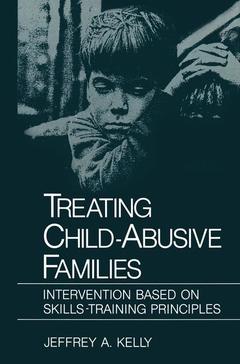Treating Child-Abusive Families, Softcover reprint of the original 1st ed. 1983 Intervention Based on Skills-Training Principles NATO Science Series B: Series
Langue : Anglais
Auteur : Kelly Jeffrey A.

During the past ten years, the problem of child abuse has been the subject of increased attention both in the professional community and among the general public. The reasons for this widespread recogni tion are clear. First, professionals of many disciplines deal with child abusive families and do so in a variety of ways: Physicians, hospital staff, and teachers are often the first to assess a child as the victim of abuse; social workers and child-protective personnel investigate cases of suspected abuse; court and legal authorities make determinations concerning the needs of an abused child; and mental health profes sionals, including psychologists, social workers, and family coun selors, often have responsibility for treating abusive families. Few clinical problems have received this kind of widespread interdisci plinary recognition and, given the nature and seriousness of child abusive behavior, few problems receive such intensive attention within each profession's literature. A second factor responsible for increased study of child abuse is the fact that violence directed toward children is probably the most extreme form of family dysfunction seen by counselors, therapists, and other practitioners. While other types of child-management and anger-control problems occur far more frequently, the consequences of child-abusive behavior are much more serious than the conse quences of other problems seen in child or family clinics. It has been v vi PREFACE estimated that as many as 550,000 children are the targets of parental abuse in the country each year (Helfer & Kemper, 1976).
1: The Incidence and Scope of Child-Abusive Behavior.- 2: Characteristics of Abusive Parents and Abused Children.- 3: A Social-Learning Model of Child Abuse.- 4: The Clinical Assessment of Child-Abusive Families.- 5: Training Abusive Parents to Use Nonviolent Child Discipline Strategies.- 6: Teaching Parents to Use Positive Reinforcement Skills.- 7: Anger-Control Training for Abusive Parents.- 8: Intervening to Reduce Life-Style Risk Factors of Abusive Parents.- 9: Interdisciplinary Team Coordination in Abuse Cases.- 10: Directions for Preventive Intervention.- Appendix I: The Eyberg Child Behavior Inventory.- Appendix II: Knowledge of Behavioral Principles as Applied to Children.- Appendix III: Deep Muscle Relaxation Training Script.- References.- Author Index.
Date de parution : 06-2013
Ouvrage de 220 p.
15.5x23.5 cm
Disponible chez l'éditeur (délai d'approvisionnement : 15 jours).
Prix indicatif 52,74 €
Ajouter au panierThème de Treating Child-Abusive Families :
Mots-clés :
Management; Nation; Skills-Training; Training; assessment; attention; intervention; reinforcement
© 2024 LAVOISIER S.A.S.



